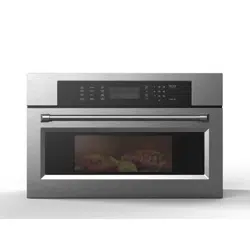Loading ...
Loading ...
Loading ...

6
Before you begin
Before you begin
Tools and parts needed
Philips head screwdriver
1/8" drill bit and drill
Measuring tape
Knife
Parts included
Microwave oven
Philips head screws
Power Requirements
The outlet must be properly grounded in accordance with
all applicable codes.
It can be installed in the back wall directly behind the
appliance.
Checklist for Installation
Use this checklist to verify that you have completed each
step of the installation process. This can help you avoid
mistakes.
Refer to detailed instructions for each step in the
sections following this checklist.
1.
Before installing the appliance, be sure to verify the
cabinet dimensions are correct for your appliance and
that the required electrical connections are present.
Make sure the electrical conduit provided on the
appliance is able to reach to the point of connection.
Section: Dimensions and Cabinet Requirements
2.
Move the appliance into place in front of the cabinet
opening.
Section: Removing Packaging
3.
Remove packaging materials, leaving the bottom
packaging on the appliance to avoid damage to the
floor.
Section: Removing Packaging
4.
Team-lift the appliance directly into the cabinet cutout.
Section: Install Appliance, "Mount to Cabinet”
5.
Slide the appliance all the way into place.
Section: Install Appliance, "Mount to Cabinet”
6.
Fasten the appliance to the cabinet opening with the
screws supplied.
Section: Install Appliance, "Mount to Cabinet”
Always read and follow the complete installation
instructions contained in this manual.
Causes of damage
Caution!
Creation of sparks: Metal e.g. a spoon in a glass must be
kept at least 2 cm from the oven walls and the inside of the
door. Sparks could irreparably damage the glass on the inside
of the door.
Water in the hot cooking compartment: Never pour water into
the hot cooking compartment. This will cause steam. The
temperature change can cause damage.
Moist food: Do not store moist food in the closed cooking
compartment for long periods.
Do not use the appliance to store food. This can lead to
corrosion.
Cooling with the appliance door open: Only leave the cooking
compartment to cool with the door closed. Do not trap anything
in the appliance door. Even if the door is only slightly ajar, the
fronts of adjacent units may be damaged over time.
Heavily soiled seal: If the seal is very dirty, the appliance door
will no longer close properly during operation. The fronts of
adjacent units could be damaged. Always keep the seal clean.
Operating the microwave without food: Operating the appliance
without food in the cooking compartment may lead to
overloading. Never switch on the appliance unless there is food
in the cooking compartment. An exception to this rule is a short
crockery test (see the section "Microwave, suitable crockery").
Using the appliance door for standing on or placing objects on:
Do not stand or place anything on the open appliance door. Do
not place ovenware or accessories on the appliance door.
Transporting the appliance: Do not carry or hold the appliance
by the door handle. The door handle cannot support the weight
of the appliance and could break.
Microwave popcorn: Never set the microwave power too high.
Use a power setting no higher than 600 watts. Always place the
popcorn bag on a glass plate. The disc may jump if overloaded.
Liquid that has boiled over must not be allowed to run through
the turntable drive into the interior of the appliance. Monitor the
cooking process. Choose a shorter cooking time initially, and
increase the cooking time as required.
The oven should be cleaned regularly and any food deposits
removed since they may explode, even after microwave heating
has ended.
Failure to maintain the oven in a clean condition could lead to
deterioration of the surface that could adversely affect the life of
the appliance and possibly result in a hazardous situation.
Loading ...
Loading ...
Loading ...
